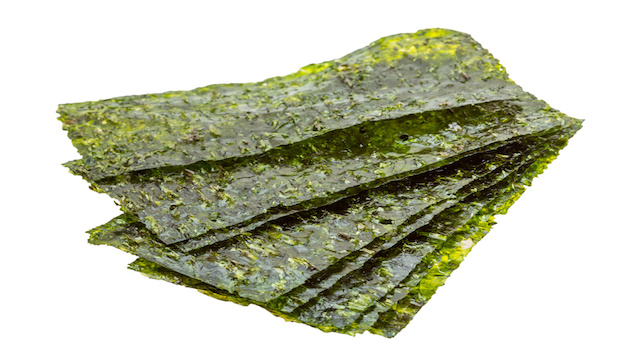
Did you know approximately 40 percent of the world’s population is at risk of developing an iodine deficiency? Iodine is a trace element, meaning our bodies only need a minute amount for proper growth, development and physiology. Our list of top nine iodine-rich foods will help you find ways to include this essential trace element in your diet.
Why do we need iodine?
Research conducted by the World Health Organization (WHO) suggests that without iodine in our diet, we risk developing adverse thyroid conditions such as goiters, hyperthyroidism, hypothyroidism and pregnancy-related problems. In fact, iodine deficiency is the most common cause of preventable mental retardation.
All symptoms of iodine deficiency relate to the thyroid. Since our bodies don’t make iodine, it’s important that our foods provide an adequate source. Iodine is naturally present in some foods and added to others.
You can maintain adequate iodine in your diet by using table salt, which has been iodized. However, if you prefer using sea salt to avoid the other additives in table salt (like sugar and anticaking agents), or you restrict the amount of salt in your diet, then you need to explore iodine-rich foods.
How much iodine do we need?
You can have too much of a good thing. According to the National Institutes of Health (NIH), this is particularly true for iodine if you suffer from thyroid issues such as nodules, hyperthyroidism and autoimmune thyroid disease. Taking large amounts of iodine, whether through medication or dietary sources, can cause or worsen hyperthyroidism and hypothyroidism.
The NIH suggests that the recommended dietary allowance (RDA) for males and females 14 years and older is 150 micrograms (mcg). Pregnant women need 220 mcg and lactating women need 290 mcg. Children from one to eight years old require 90 mcg, and children from nine to 13 years old require 120 mcg.
Here is our list of the top nine foods rich in iodine.
Dried seaweed
A staple in Japanese cuisine, dried seaweed, often sold as nori or kelp, absorbs iodine from the water, making it an excellent source. However, since one sheet provides as much as 2,984 mcg, you could easily go over your RDA. So, eat dried seaweed in moderation.
Codfish
Cod, a favorite in soups and stews, is an excellent low-calorie protein available throughout the year. This coldwater fish is also a healthy source of iodine. A three-ounce portion delivers 99 mcg.
Haddock
Haddock, another low-calorie seafood delight is meaty and mild in flavor. Two and a half ounces provides 87 mcg of iodine. Forgo the frying; sauté instead with a little butter, olive oil or coconut oil for a healthy alternative.
Dairy
Dairy is an excellent source of iodine. Cottage cheese ranks the highest with one cup providing 65 mcg of iodine. One cup of any type of milk provides 52 to 62 mcg of iodine. Three-quarters of a cup of plain yogurt provides 58 mcg.
Turkey
Turkey, a healthy source of lean protein, is also an excellent source of iodine. A three-ounce portion provides 30 mcg. Choose pasture-raised and organic-fed.
Beans
Beans, not just for dinner — have them for breakfast. Touted as a superfood, beans are rich in protein, high in fiber and antioxidants. Three-quarters of a cup of cooked navy beans or black-eyed peas provides 46 to 53 mcg of iodine. Three-quarters of a cup of pinto or kidney beans provides 19–28 mcg.
Eggs
The versatile egg is great at any time of the day. Choose two large free-range eggs for 48–52 mcg of iodine.
Beef liver
 Beef liver is a protein powerhouse, loaded with vitamins, minerals and amino acids. Two and a half ounces contain 32 mcg of iodine. Choose organic liver from grass-fed animals. Non-organic liver is more likely to contain traces of antibiotics, growth hormones and GMO feed.
Beef liver is a protein powerhouse, loaded with vitamins, minerals and amino acids. Two and a half ounces contain 32 mcg of iodine. Choose organic liver from grass-fed animals. Non-organic liver is more likely to contain traces of antibiotics, growth hormones and GMO feed.
Shrimp
Shrimp is a lean source of high-quality protein and a good natural source of iodine. Three ounces provides a 35-mcg dose of iodine. However, since shrimp are so low in omega-3 fatty acids, add them to a stir-fry with lots of organic veggies, or toss them into a lightly dressed salad.
Iodine content is not listed on food packaging in the U.S. Therefore, it’s often difficult to identify sources of iodine. Furthermore, there are no tests to confirm whether you have enough iodine in your body.
Since even mild iodine deficiency during pregnancy can affect the development of a child, pregnant and breastfeeding women should speak with their health-care professional about taking a multivitamin that contains at least 150 mcg of iodine per day.
If you have any symptoms or concerns about your thyroid, talk to your health-care provider about iodine and include these delicious foods in your routine!
—The Alternative Daily
Sources:
http://apps.who.int/iris/bitstream/10665/43010/1/9241592001.pdf
https://ods.od.nih.gov/factsheets/Iodine-HealthProfessional
http://www.dietitians.ca/Your-Health/Nutrition-A-Z/Minerals/Food-Sources-of-Iodine.aspx
http://www.mayoclinic.org/healthy-lifestyle/nutrition-and-healthy-eating/expert-answers/sea-salt/faq-20058512
http://www.nap.edu/read/10026/chapter/2
http://www.whfoods.com/genpage.php?tname=foodspice&dbid=125

